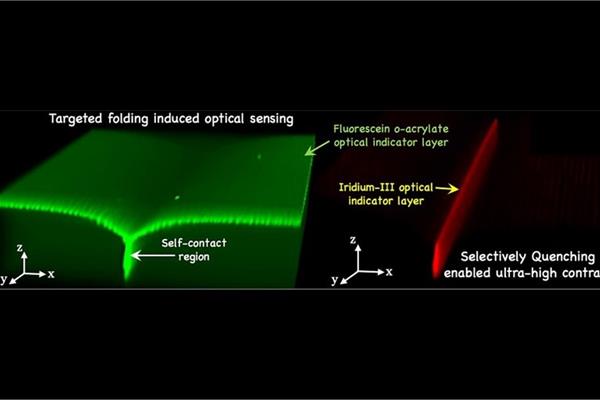
Inspired by the way plants and animals can change colour in nature, scientists from Northumbria University have developed a new optical sensing technology which can light up areas of an object or material by creating microscopic wrinkles and folds within its surface.
To create this new technology, that could have a variety of practical applications, including within flexible wearable devices, electronics, and in 3D printing, scientists created first a thin film which, when stimulated with a mechanical or electronic signal, results in microscopic folds being created on its surface.
Researchers then created a chemical paint to apply to the material that creates a chemical reaction due to the change in oxygen levels when the folds are created in the surface. This reaction creates a luminescent effect, making the wrinkled area of the surface appear to 'light up'.
From unwanted phenomena to an innovative function
When subjected to mechanical stimuli, elastomeric materials such as that created by the Northumbria University researchers can undergo surface changes, such as wrinkles and cracks. This can be used to create switchable optical features and structural colour with dynamic luminescent patterns.
Dr Xu, an associate professor in Mechanical Engineering, led the project and said: "Wrinkles and folds are usually unwanted in engineering terms. Similarly, an oxygen quenching effect is not popular in fluorescence science. However, through micro-engineering, magic happened, and two unwanted phenomena were turned into a responsive and programmable 'fold to glitter' function."
Inspired by nature
The phenomenon of elastic wrinkling and folding exists widely in nature, which has actually inspired academics to investigate the mathematical and physical science behind these changes and to explore how this could be used for innovative engineering solutions.
"This is exciting new research with a number of emerging applications in flexible and wearable electronics and bio-devices", said Professor John Woodward, Pro Vice-Chancellor of Northumbria University's Faculty of Engineering and Environment.
An international collaboration
The research, entitled
A flexible topo-optical sensing technology with ultra-high contrast, was carried out by Dr Ben Bin Xu and Dr Yifan Li, from Northumbria University's Department of Mechanical and Construction Engineering, and Dr Valery Kozhevnikov from Northumbria's Department of Applied Sciences, and it's been publishes in the scientific journal Nature Communications.
The work at Northumbria is part of a wider international collaborative research programme which also involved Prof Jie Kong from Northwestern Polytechnical University in China and Prof Ben Zhong Tang from Hong Kong University of Science and Technology.
It has been supported by the Engineering and Physical Sciences Research Council (EPSRC) and the Royal Society Kan Tong Po International Fellowship 2019.
Professor Laurent Dala, head of Northumbria's Department of Mechanical and Construction Engineering, added: "The outcomes show promise for future international collaboration between Northumbria University, Northwestern Polytechnic University, China and Hong Kong University of Science and Technology and indicate the benefit of UKRI finding International research teams through fellowship grants."